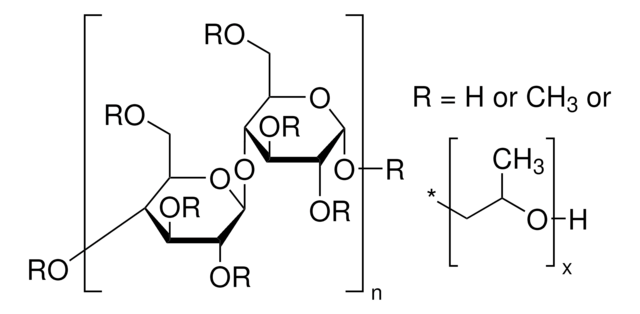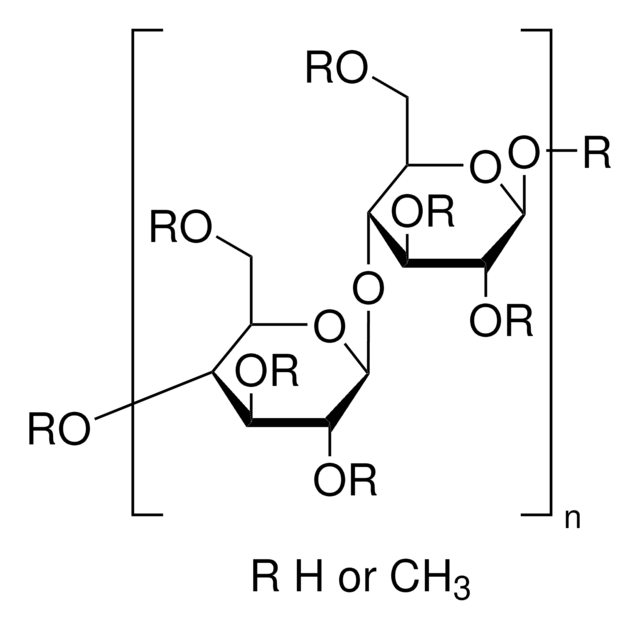Wszystkie zdjęcia(4)
Kluczowe dokumenty
H7509
(Hydroxypropyl)methyl cellulose
viscosity 2,600-5,600 cP, 2 % in H2O(20 °C)(lit.)
Synonim(y):
2-Hydroxypropyl methyl cellulose ether
Zaloguj sięWyświetlanie cen organizacyjnych i kontraktowych
About This Item
Polecane produkty
pochodzenie biologiczne
plant
Poziom jakości
Formularz
powder
masa cząsteczkowa
~86 kDa
kolor
white to off-white
lepkość
2,600-5,600 cP, 2 % in H2O(20 °C)(lit.)
rozpuszczalność
water: 10 mg/mL, clear to very slightly hazy, colorless
temp. przechowywania
room temp
Szukasz podobnych produktów? Odwiedź Przewodnik dotyczący porównywania produktów
Opis ogólny
(Hydroxypropyl)methylcellulose (HPMC) is a water-soluble polymer derived from cellulose. This polysaccharide forms colloids when dissolved in water. HPMC is a hydrocolloid produced artificially from natural substances. It consists of 28-30% methoxyl content and 7-12% of hydroxypropoxyl content.
Zastosowanie
(Hydroxypropyl)methyl cellulose (HPMC) has been used:
- as a viscosity modifier in the preparation of printable ink
- as a viscosifier in the preparation of hydroxyapatite (HAP) suspension
- in the preparation of HPMC gels and composite gels
Thickener for aqueous and non-aqueous systems, clear films with grease resistance, binders, lubricants, steric stabilizer and water retention aid.
Działania biochem./fizjol.
(Hydroxypropyl)methylcelluloses (HPMCs) act as suspension aids, surfactants, lubricants, protective colloids, and emulsifiers. Additionally, solutions of these polymers show thermal gelation properties. They are generally used as binders, thickeners, film formers, and water retention agents. HPMC also elicits surface-active properties.
Cechy i korzyści
Dissolves in water, undergoes reversible gelation upon heating, non-ionic, does not complex with ionic species and is surface active and enzyme resistant. Solutions are pseudoplastic.
Inne uwagi
To gain a comprehensive understanding of our extensive range of Polysaccharides for your research, we encourage you to visit our Carbohydrates Category page.
Ta strona może zawierać tekst przetłumaczony maszynowo.
Kod klasy składowania
11 - Combustible Solids
Klasa zagrożenia wodnego (WGK)
WGK 1
Temperatura zapłonu (°F)
Not applicable
Temperatura zapłonu (°C)
Not applicable
Środki ochrony indywidualnej
Eyeshields, Gloves, type N95 (US)
Wybierz jedną z najnowszych wersji:
Masz już ten produkt?
Dokumenty związane z niedawno zakupionymi produktami zostały zamieszczone w Bibliotece dokumentów.
Klienci oglądali również te produkty
Jenny Högström et al.
Cancer research, 78(20), 5820-5832 (2018-08-30)
The homeobox transcription factor PROX1 is induced by high Wnt/β-catenin activity in intestinal adenomas and colorectal cancer, where it promotes tumor progression. Here we report that in LGR5+ colorectal cancer cells, PROX1 suppresses the Notch pathway, which is essential for
Alexandre Goyon et al.
Electrophoresis, 39(16), 2083-2090 (2018-05-19)
The determination of mAb critical quality attributes (CQA) is crucial for their successful application in health diseases. A generic CZE method was developed for the high-resolution separation of various mAb charge variants, which are often recognized as important CQA. A
Bernd Moritz et al.
Electrophoresis, 38(24), 3136-3146 (2017-09-10)
CZE is a well-established technique for charge heterogeneity testing of biopharmaceuticals. It is based on the differences between the ratios of net charge and hydrodynamic radius. In an extensive intercompany study, it was recently shown that CZE is very robust
Mylène Tajan et al.
Nature communications, 12(1), 366-366 (2021-01-16)
Many tumour cells show dependence on exogenous serine and dietary serine and glycine starvation can inhibit the growth of these cancers and extend survival in mice. However, numerous mechanisms promote resistance to this therapeutic approach, including enhanced expression of the de
Francis W Hunter et al.
Biochemical pharmacology, 89(2), 224-235 (2014-03-19)
The nitro-chloromethylbenzindoline prodrug SN29428 has been rationally designed to target tumour hypoxia. SN29428 is metabolised to a DNA minor groove alkylator via oxygen-sensitive reductive activation initiated by unknown one-electron reductases. The present study sought to identify reductases capable of activating
Nasz zespół naukowców ma doświadczenie we wszystkich obszarach badań, w tym w naukach przyrodniczych, materiałoznawstwie, syntezie chemicznej, chromatografii, analityce i wielu innych dziedzinach.
Skontaktuj się z zespołem ds. pomocy technicznej



